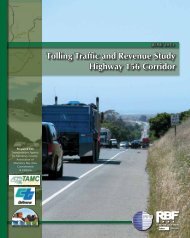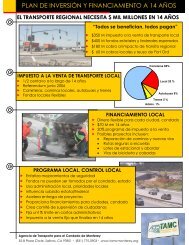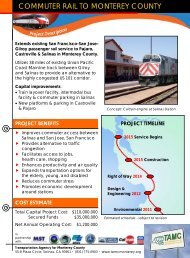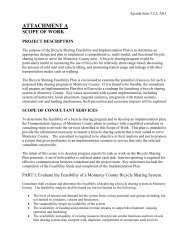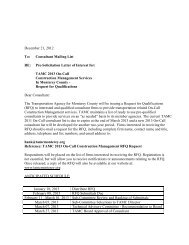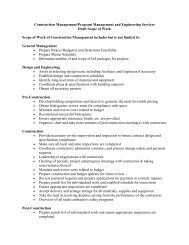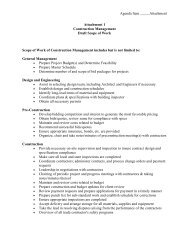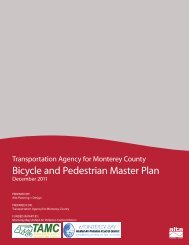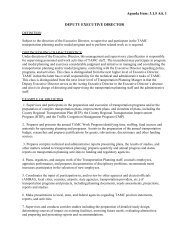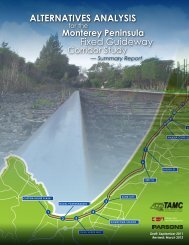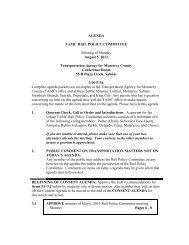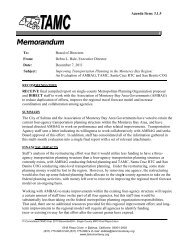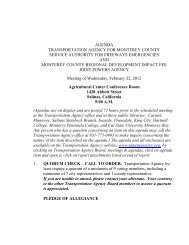CALTRAIN EXTENSION TO MONTEREY COUNTYALTERNATIVES ANALYSISestablished as part of this alternative and would operate from four Monterey County Transit Centersto the San Francisco Bay Area. An MST Transit Center/Park-n-Ride facility would be constructed atEighth Street in Marina as part of the University Villages redevelopment of Fort Ord. Additional transitcenters with park-and-ride facilities would be located in Salinas, Castroville, and Pajaro with expressbus service operating via existing surface roadways to Santa Clara and San Mateo counties,including non-stop service to selected stations.The Express Bus Alternative also includes the construction of park-and-ride facilities to supportexpress bus operations at comparable Caltrain <strong>Extension</strong> Alternative rail station locations. These willinclude Salinas, Castroville, Pajaro/Watsonville, and Marina (Fort Ord). High-speed transmission,over the road, 40-foot coaches would be acquired for this service with a capacity of 45 to 49passengers per vehicle. Twenty-five vehicles (plus five spares) would be required to operate theservice in the near term—carrying 1,028 commuters to the San Francisco Bay Area each weekday.Of these, 21 vehicles would operate to/from Santa Clara County and four vehicles would operateto/from San Mateo and San Francisco counties. This is equivalent to two Caltrain trips extended fromGilroy to Salinas. Longer term, a fleet of 60 motor coaches (50 vehicles in revenue service plus 10spares) would be required to accommodate the four Caltrain each way ridership scenario. The samefare structure as proposed for the Caltrain <strong>Extension</strong> Alternative is assumed for the Express BusAlternative. All fare revenues will be used to offset operating and maintenance expenses. Table 9-2outlines the Express Bus Alternative capital cost estimates.Table 9-2Express Bus Alternative Capital Cost Estimate ($1,000 FY 2007)Work DescriptionPajaroPark-and-RideCastrovilleParkand-RideSalinasStationSalinasBusSalinasPark-and-RideMarinaBusMarinaParkand-Ride2007TotalsYOETotalsParking and access $2,227 $1,426 — $1,215 $ 8,888 $ 485 $1,390 $15,631 $17,194Pedestrian structures — 900 — — — — — 900 990Platform and station amenities 576 453 2,301 1,298 — 1,204 — 5,832 6,415Track and signal improvements — 605 316 — — — — 921 1,013Specialty items 50 100 75 50 — — — 275 303Mobilization 285 349 269 256 889 169 139 2,356 2,592Contingencies 1,098 1,341 1,036 987 1,955 650 535 7,602 8,362Construction Total $4,236 $5,174 $3,997 $3,806 $11,732 $2,508 $2,064 $33,517 36,271Soft cost 1,398 1,707 1,319 1,256 4,106 702 681 11,169 11,741Right-of-way 2,170 409 — 4,250 1,650 74 2,622 11,175 11,593Subtotal $7,804 $7,290 $5,316 $9,312 $17,488 $3,284 $5,367 $55,861 59,605Vehicles — — — — — — — 30,000 36,383Maintenance facility — — — — — — — 6,000 6,493Unallocated contingency — — — — — — — 4,593 4,866Total $7,804 $7,290 $5,316 $9,312 $17,488 $3,284 $5,367 $96,454 $107,347parsons CHAPTER 9: SUMMARY 223
CALTRAIN EXTENSION TO MONTEREY COUNTYALTERNATIVES ANALYSISDETAILED EVALUATION OF ALTERNATIVESThe <strong>Alternatives</strong> <strong>Analysis</strong> study prepared a detailed evaluation of how well each alternative/alignmentoption can meet the goals and objectives established for the project:• Improve mobility• Improve the environment• Optimize transit operating efficiencies• Provide a cost-effective solution• Support local land use plans and respond to growthThe evaluation methodology was designed to ensure that both local priorities and Federal TransitAdministration criteria are met. Table 9-3 shows some of the key results of the evaluation. Theseresults compare the Caltrain <strong>Extension</strong> Alternative and the Express Bus Alternative for the selectedevaluation criteria, including cost and various user benefits. The benefits monetized in Table 3 areexpressed as positive dollars, while costs are expressed as (negative) dollars. Table 9-3demonstrates that the benefits of the Caltrain <strong>Extension</strong> Alternative exceed the benefits of theExpress Bus Alternative in both 2010 and 2030.Table 9-3Summary of Caltrain <strong>Extension</strong> and Express Bus Alternative Benefits2010 2030Benefit Type Caltrain Express Bus Caltrain Express BusUser BenefitsIn-vehicle travel time (Method 3) $ 252,032 $ 252,032 $ 6,985,931 $ 4,160,454Fuel costs 4,499,622 4,499,622 8,631,039 8,631,039Non-fuel operating savings 1,925,316 1,925,316 3,693,083 3,693,083Transit user fees (3,310,612) (3,310,612) (6,320,790) (6,320,790)Internal accident costs or savings—Highway 3,144,040 3,144,040 6,027,934 6,027,934Transit (150,545) (893,907) (304,004) (1,698,612)Revenue Transfers (fuel taxes) (893,915) (893,915) (1,714,681) (1,714,681)Reduction in External CostsEmissions 14,361 (105,368) (136,415) (381,210)Highway accidents 554,830 554,830 1,063,753 1,063,753Transit accidents (14,406) (148,306) (28,744) (284,432)Net Public Operating Costs (1,175,068) (5,256,095) (2,393,619) (10,812,623)Total $4,845,655 ($232,363) $15,503,487 $2,363,915The evaluation of the Caltrain <strong>Extension</strong> and Express Bus alternatives assumed equal ridership forboth the commuter rail and express bus modes. For this reason, most of the user benefits identifiedabove are equal between the Caltrain and Express bus options. By the Year 2030, in-vehicle traveltime for the Express Bus Alternative will be longer due to increased roadway congestion; however, forthe most part benefits are the same or similar between the two modal options. One significantdifference is “Net Public Operating Costs,” which is the difference between total operations and maintenanceexpense and fare revenues (transit user fees) paid to ride the service. Operation of a largebus fleet with limited seating capacity between Monterey County and San Francisco Peninsulastations is far more expensive than the incremental cost of extending Caltrain service 37 miles fromGilroy to Salinas.parsons CHAPTER 9: SUMMARY 224
- Page 4 and 5:
DRAFTCALTRAIN EXTENSIONTO MONTEREY
- Page 6 and 7:
CALTRAIN EXTENSION TO MONTEREY COUN
- Page 8 and 9:
CALTRAIN EXTENSION TO MONTEREY COUN
- Page 10 and 11:
CALTRAIN EXTENSION TO MONTEREY COUN
- Page 12 and 13:
CALTRAIN EXTENSION TO MONTEREY COUN
- Page 14 and 15:
CALTRAIN EXTENSION TO MONTEREY COUN
- Page 16 and 17:
CALTRAIN EXTENSION TO MONTEREY COUN
- Page 18 and 19:
CALTRAIN EXTENSION TO MONTEREY COUN
- Page 20 and 21:
CALTRAIN EXTENSION TO MONTEREY COUN
- Page 22 and 23:
CALTRAIN EXTENSION TO MONTEREY COUN
- Page 24 and 25:
CALTRAIN EXTENSION TO MONTEREY COUN
- Page 26 and 27:
CALTRAIN EXTENSION TO MONTEREY COUN
- Page 28 and 29:
CALTRAIN EXTENSION TO MONTEREY COUN
- Page 30 and 31:
CALTRAIN EXTENSION TO MONTEREY COUN
- Page 32 and 33:
CALTRAIN EXTENSION TO MONTEREY COUN
- Page 34 and 35:
CALTRAIN EXTENSION TO MONTEREY COUN
- Page 36 and 37:
CALTRAIN EXTENSION TO MONTEREY COUN
- Page 38 and 39:
CALTRAIN EXTENSION TO MONTEREY COUN
- Page 40 and 41:
CALTRAIN EXTENSION TO MONTEREY COUN
- Page 42 and 43:
CALTRAIN EXTENSION TO MONTEREY COUN
- Page 44 and 45:
CALTRAIN EXTENSION TO MONTEREY COUN
- Page 46 and 47:
CALTRAIN EXTENSION TO MONTEREY COUN
- Page 48 and 49:
CALTRAIN EXTENSION TO MONTEREY COUN
- Page 50 and 51:
CALTRAIN EXTENSION TO MONTEREY COUN
- Page 52 and 53:
CALTRAIN EXTENSION TO MONTEREY COUN
- Page 54 and 55:
CALTRAIN EXTENSION TO MONTEREY COUN
- Page 56 and 57:
CALTRAIN EXTENSION TO MONTEREY COUN
- Page 58 and 59:
CALTRAIN EXTENSION TO MONTEREY COUN
- Page 60 and 61:
CALTRAIN EXTENSION TO MONTEREY COUN
- Page 62 and 63:
CALTRAIN EXTENSION TO MONTEREY COUN
- Page 64 and 65:
CALTRAIN EXTENSION TO MONTEREY COUN
- Page 66 and 67:
CALTRAIN EXTENSION TO MONTEREY COUN
- Page 68 and 69:
CALTRAIN EXTENSION TO MONTEREY COUN
- Page 70 and 71:
CALTRAIN EXTENSION TO MONTEREY COUN
- Page 72 and 73:
CALTRAIN EXTENSION TO MONTEREY COUN
- Page 74 and 75:
CALTRAIN EXTENSION TO MONTEREY COUN
- Page 76 and 77:
CALTRAIN EXTENSION TO MONTEREY COUN
- Page 78 and 79:
CALTRAIN EXTENSION TO MONTEREY COUN
- Page 80 and 81:
CALTRAIN EXTENSION TO MONTEREY COUN
- Page 82 and 83:
CALTRAIN EXTENSION TO MONTEREY COUN
- Page 84 and 85:
CALTRAIN EXTENSION TO MONTEREY COUN
- Page 86 and 87:
CALTRAIN EXTENSION TO MONTEREY COUN
- Page 88 and 89:
CALTRAIN EXTENSION TO MONTEREY COUN
- Page 90 and 91:
CALTRAIN EXTENSION TO MONTEREY COUN
- Page 92 and 93:
CALTRAIN EXTENSION TO MONTEREY COUN
- Page 94 and 95:
CALTRAIN EXTENSION TO MONTEREY COUN
- Page 96 and 97:
CALTRAIN EXTENSION TO MONTEREY COUN
- Page 98 and 99:
CALTRAIN EXTENSION TO MONTEREY COUN
- Page 100 and 101:
CALTRAIN EXTENSION TO MONTEREY COUN
- Page 102 and 103:
CALTRAIN EXTENSION TO MONTEREY COUN
- Page 104 and 105:
CALTRAIN EXTENSION TO MONTEREY COUN
- Page 106 and 107:
CALTRAIN EXTENSION TO MONTEREY COUN
- Page 108 and 109:
CALTRAIN EXTENSION TO MONTEREY COUN
- Page 110 and 111:
CALTRAIN EXTENSION TO MONTEREY COUN
- Page 112 and 113:
CALTRAIN EXTENSION TO MONTEREY COUN
- Page 114 and 115:
CALTRAIN EXTENSION TO MONTEREY COUN
- Page 116 and 117:
CALTRAIN EXTENSION TO MONTEREY COUN
- Page 118 and 119:
CALTRAIN EXTENSION TO MONTEREY COUN
- Page 120 and 121:
CALTRAIN EXTENSION TO MONTEREY COUN
- Page 122 and 123:
CALTRAIN EXTENSION TO MONTEREY COUN
- Page 124 and 125:
CALTRAIN EXTENSION TO MONTEREY COUN
- Page 126 and 127:
CALTRAIN EXTENSION TO MONTEREY COUN
- Page 128 and 129:
CALTRAIN EXTENSION TO MONTEREY COUN
- Page 130 and 131:
CALTRAIN EXTENSION TO MONTEREY COUN
- Page 132 and 133:
CALTRAIN EXTENSION TO MONTEREY COUN
- Page 134 and 135:
CALTRAIN EXTENSION TO MONTEREY COUN
- Page 136 and 137:
CALTRAIN EXTENSION TO MONTEREY COUN
- Page 138 and 139:
CALTRAIN EXTENSION TO MONTEREY COUN
- Page 140 and 141:
CALTRAIN EXTENSION TO MONTEREY COUN
- Page 142 and 143:
CALTRAIN EXTENSION TO MONTEREY COUN
- Page 144 and 145:
CALTRAIN EXTENSION TO MONTEREY COUN
- Page 146 and 147:
CALTRAIN EXTENSION TO MONTEREY COUN
- Page 148 and 149:
CALTRAIN EXTENSION TO MONTEREY COUN
- Page 150 and 151:
CALTRAIN EXTENSION TO MONTEREY COUN
- Page 152 and 153:
CALTRAIN EXTENSION TO MONTEREY COUN
- Page 154 and 155:
CALTRAIN EXTENSION TO MONTEREY COUN
- Page 156 and 157:
CALTRAIN EXTENSION TO MONTEREY COUN
- Page 158 and 159:
CALTRAIN EXTENSION TO MONTEREY COUN
- Page 160 and 161:
CALTRAIN EXTENSION TO MONTEREY COUN
- Page 162 and 163:
CALTRAIN EXTENSION TO MONTEREY COUN
- Page 164 and 165:
CALTRAIN EXTENSION TO MONTEREY COUN
- Page 166 and 167:
CALTRAIN EXTENSION TO MONTEREY COUN
- Page 168 and 169:
CALTRAIN EXTENSION TO MONTEREY COUN
- Page 170 and 171:
CALTRAIN EXTENSION TO MONTEREY COUN
- Page 172 and 173:
CALTRAIN EXTENSION TO MONTEREY COUN
- Page 174 and 175:
CALTRAIN EXTENSION TO MONTEREY COUN
- Page 176 and 177:
CALTRAIN EXTENSION TO MONTEREY COUN
- Page 178 and 179:
CALTRAIN EXTENSION TO MONTEREY COUN
- Page 180 and 181:
CALTRAIN EXTENSION TO MONTEREY COUN
- Page 182 and 183:
CALTRAIN EXTENSION TO MONTEREY COUN
- Page 184 and 185:
CALTRAIN EXTENSION TO MONTEREY COUN
- Page 186 and 187:
CALTRAIN EXTENSION TO MONTEREY COUN
- Page 188 and 189:
CALTRAIN EXTENSION TO MONTEREY COUN
- Page 190 and 191:
CALTRAIN EXTENSION TO MONTEREY COUN
- Page 192 and 193:
CALTRAIN EXTENSION TO MONTEREY COUN
- Page 194 and 195:
CALTRAIN EXTENSION TO MONTEREY COUN
- Page 196 and 197:
CALTRAIN EXTENSION TO MONTEREY COUN
- Page 198 and 199:
CALTRAIN EXTENSION TO MONTEREY COUN
- Page 200 and 201:
CALTRAIN EXTENSION TO MONTEREY COUN
- Page 202 and 203:
CALTRAIN EXTENSION TO MONTEREY COUN
- Page 204 and 205:
CALTRAIN EXTENSION TO MONTEREY COUN
- Page 206 and 207: CALTRAIN EXTENSION TO MONTEREY COUN
- Page 208 and 209: CALTRAIN EXTENSION TO MONTEREY COUN
- Page 210 and 211: CALTRAIN EXTENSION TO MONTEREY COUN
- Page 212 and 213: CALTRAIN EXTENSION TO MONTEREY COUN
- Page 214 and 215: CALTRAIN EXTENSION TO MONTEREY COUN
- Page 216 and 217: CALTRAIN EXTENSION TO MONTEREY COUN
- Page 218 and 219: CALTRAIN EXTENSION TO MONTEREY COUN
- Page 220 and 221: CALTRAIN EXTENSION TO MONTEREY COUN
- Page 222 and 223: CALTRAIN EXTENSION TO MONTEREY COUN
- Page 224 and 225: CALTRAIN EXTENSION TO MONTEREY COUN
- Page 226 and 227: CALTRAIN EXTENSION TO MONTEREY COUN
- Page 228 and 229: CALTRAIN EXTENSION TO MONTEREY COUN
- Page 230 and 231: CALTRAIN EXTENSION TO MONTEREY COUN
- Page 232 and 233: CALTRAIN EXTENSION TO MONTEREY COUN
- Page 234 and 235: CALTRAIN EXTENSION TO MONTEREY COUN
- Page 236 and 237: CALTRAIN EXTENSION TO MONTEREY COUN
- Page 238 and 239: CALTRAIN EXTENSION TO MONTEREY COUN
- Page 240 and 241: CALTRAIN EXTENSION TO MONTEREY COUN
- Page 242 and 243: CALTRAIN EXTENSION TO MONTEREY COUN
- Page 244 and 245: CALTRAIN EXTENSION TO MONTEREY COUN
- Page 246 and 247: CALTRAIN EXTENSION TO MONTEREY COUN
- Page 248 and 249: CALTRAIN EXTENSION TO MONTEREY COUN
- Page 250 and 251: CALTRAIN EXTENSION TO MONTEREY COUN
- Page 252 and 253: CALTRAIN EXTENSION TO MONTEREY COUN
- Page 254 and 255: CALTRAIN EXTENSION TO MONTEREY COUN
- Page 258 and 259: CALTRAIN EXTENSION TO MONTEREY COUN
- Page 260 and 261: CALTRAIN EXTENSION TO MONTEREY COUN
- Page 262 and 263: CALTRAIN EXTENSION TO MONTEREY COUN
- Page 264 and 265: CALTRAIN EXTENSION TO MONTEREY COUN



